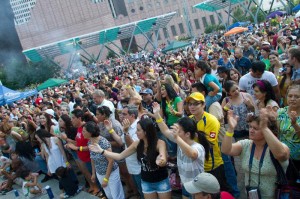Houston Brazilian Festival

Care to Dance?
Houston Brazilian Festival Returns to Jones Plaza
You don’t have to wait for anyone to ask you to dance in Brazil, so why should you have to wait at Jones Plaza, the site of the Houston Brazilian Festival, which runs from 1 to 10pm on Sunday, September 2? Four different bands will perform everything from samba to bossa nova, Brazilian pop and samba reggae to Afro-funk. Festival founder Mauricio Campos, who teaches capoeira and runs the Brazilian Arts Foundation, which he founded a decade after moving to Houston in 1990, offered this advice , “just get up and dance.”
“In Brazil, if three or four people are talking, and somebody starts beating a rhythm on a table, somebody will start dancing. Here, it’s a little different,” he said. “Brazilians are not very shy about these things.”
The festival, a once-a-year affair that attracted over 3,000 attendees in 2011, is part of Campos’ attempt to promote the arts and culture of his native country. “We try to offer things that reflect the way we are—how we love, how we dance, how we eat, how we interact with other people,” Campos said. “It’s an energy we have with people. The way we walk, the way we talk. It’s the closeness of people in Brazil. We have this personality that is perceived as always festive and happy.” The Brazilian Arts Foundation offers Brazilian Portuguese lessons, dance for kids and adults, even cooking classes. The foundation is designed to offer cultural experiences to Texans and to serve as a community center for expatriate Brazilians.
At Jones Plaza, in addition to participatory dance, the Silva Dance Company from New York will perform throughout the day. The directors of this newly formed dance company, Leandro Santos Silva and Janete Silva, have been developing a fusion technique which combines Afro-Brazilian dance, capoeira (the folky, dancelike Brazilian martial art), modern dance and ballet. Videos on You-Tube which demonstrate the “Silva Technique” feature students gliding from double pirouettes to capoeira-style cartwheels. The use of the spine is reminiscent of African traditional dance, but the leaps, release and use of space all recall American modern dance choreography. It’s a fluid and all-encompassing style.
Campos and the Silvas met when they performed together in Dance Brazil, a New York-based touring company founded by Jelon Vieira in 1977 with the encouragement and advice of Alvin Ailey. Dance Brazil introduced American audiences to both traditional Afro-Brazilian dance and capoeira. During the Houston festival, Silva Dance Company members will present excerpts of dances presented in the company’s inaugural New York season this year. “They use different rhythms from Brazilian music and add a modern twist,” Campos said “They might use rock music, as well as traditional folkloric sounds.”
Although capoeira seems to have influenced Brazilian contemporary dancers, Campos said the dance community in Houston has been slow to discover the form. “There are two of us teaching in Houston, and I don’t see the dance community taking classes.”
Capoeira features singing, drumming, and an acrobatic style of “combat” which looks more like break-dancing than fighting.
The leading Brazilian playwright Dias Gomes wrote, “capoeira is a dancer’s fight… It is a gladiator dance… It is a duel of comrades… It is a game, it is a dance, it is a dispute – a perfect symbiosis of force and rhythm, poetry and agility, the only art form where the movements are commanded by music and singing. The submission of the force to the rhythm. From the violence to the melody. The subliming of the antagonisms…”
“At a capoeira class, you’re not going to get any attitude,” Campos said. “You don’t need to have done it before, or have any martial arts background. There’s always space for more people.” Tall, short, small or large, everybody is equally respected. “It’s a family environment,” he said. “In capoeira we dance like fighters, and fight like dancers.” It is a martial art that’s not based on blocking. It’s about evading everything. “You go out coming in and in going out. You have to give your entire self to it. The possibilities are endless.”
You may have to attend one of Campos’ classes at the Brazilian Arts Foundation to experience capoeira, but you can take free lessons in samba and gafieira at the festival. Samba is the social dance form that was gussied up by professional ballroom dancers to turn it into high entertainment. At its more basic level, it’s about rhythm and a few simple steps. Gafieira is a variation of the samba that’s been described as a cross between the waltz and the tango. While both these public lessons require a partner, there will also be “samba de roda” at the festival, a circle dance where male and female dancers take turns coming into the center of the circle to meet and to dance.
“Our goal is for people to have interactions. That becomes education,” Campos said. “And it’s a fun way to get the body moving.”
What: Houston Brazilian Festival: food, music, dance performances, kids’ activities.
When: Sunday, September 2, 1-10- p.m.
Where: Jones Plaza, 610 Louisiana Street
Tickets: $10 at the door or online at



Recent Comments